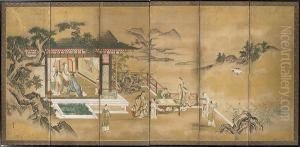Kano Tansetsu Paintings
Kano Tansetsu was a prominent Japanese painter of the Kano school, which played a significant role in the development and preservation of Japanese painting traditions from the 15th century through the Edo period. Born in 1653, Tansetsu was part of a lineage of painters who had been influential in defining the aesthetics and techniques of Japanese art for generations. The Kano school, founded by Kano Masanobu, was known for its blend of Chinese and Japanese artistic elements, integrating Zen Buddhism themes, nature, and traditional Japanese subjects into its works.
Tansetsu's contributions to the Kano school and Japanese art as a whole are notable for his adherence to and yet innovative expansion of the school's stylistic boundaries. He was adept at large-scale screen paintings, a format popular in the decoration of castles and temples, as well as smaller, more intimate works. His subjects often included landscapes, figures, and scenes from nature, characterized by fluid brushwork and a masterful use of ink and color. Tansetsu's work reflects the transition within the Kano school from its earlier, more rigidly Chinese-influenced style to a more freely expressive approach that incorporated uniquely Japanese sensibilities.
During his lifetime, Tansetsu served various daimyo (feudal lords) and contributed significantly to the beautification of their residences and castles. This was a common practice for Kano school artists, who were highly sought after for their skills and ability to convey political and cultural legitimacy through art. Tansetsu's legacy is not only in his artworks but also in his role in mentoring the next generation of artists, ensuring the continuity and evolution of the Kano school's traditions.
Despite the political and social changes occurring in Japan during Tansetsu's lifetime, he managed to maintain the relevance and prestige of the Kano school. His works are preserved in several important Japanese cultural institutions and continue to be studied for their historical significance and artistic mastery. Tansetsu's death in 1718 marked the end of an era for the Kano school but his influence persisted, contributing to the enduring legacy of one of Japan's most important artistic dynasties.
